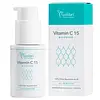What's inside
What's inside
 Key Ingredients
Key Ingredients

 Benefits
Benefits

 Ingredients Side-by-side
Ingredients Side-by-side

Water
Skin ConditioningPropanediol
SolventButylene Glycol
HumectantDiglycerin
HumectantGlycerin
Humectant1,2-Hexanediol
Skin ConditioningAscorbyl Glucoside
Antioxidant3-O-Ethyl Ascorbic Acid
Skin ConditioningPolysorbate 20
EmulsifyingSodium Citrate
BufferingXanthan Gum
EmulsifyingSodium Hydroxide
BufferingDipotassium Glycyrrhizate
HumectantNiacinamide
SmoothingMaltodextrin
AbsorbentCitric Acid
BufferingSucrose Dilaurate
EmollientSodium Cocoyl Glutamate
CleansingPisum Sativum Extract
Skin ConditioningWater, Propanediol, Butylene Glycol, Diglycerin, Glycerin, 1,2-Hexanediol, Ascorbyl Glucoside, 3-O-Ethyl Ascorbic Acid, Polysorbate 20, Sodium Citrate, Xanthan Gum, Sodium Hydroxide, Dipotassium Glycyrrhizate, Niacinamide, Maltodextrin, Citric Acid, Sucrose Dilaurate, Sodium Cocoyl Glutamate, Pisum Sativum Extract
 Reviews
Reviews

Ingredients Explained
These ingredients are found in both products.
Ingredients higher up in an ingredient list are typically present in a larger amount.
You might know this ingredient as Ethyl Ascorbic Acid, a more stable version of ascorbic acid.
Like other types of vitamin C, this ingredient has many benefits including reducing wrinkles, skin soothing, dark spot fading, and fighting against free radicals.
3-O-Ethyl Ascorbic Acid interferes with the process of skin darkening, helping to reduce hyperpigmentation. It also encourages the skin to produce more collagen.
Once applied, 3-O-Ethyl Ascorbic Acid is converted to Vitamin C deeper in the skin's layers. This process is slow but makes this ingredient more tolerable for skin.
The optimum pH range for this ingredient is 4 - 5.5
Learn more about 3-O-Ethyl Ascorbic AcidButylene Glycol (or BG) is used within cosmetic products for a few different reasons:
Overall, Butylene Glycol is a safe and well-rounded ingredient that works well with other ingredients.
Though this ingredient works well with most skin types, some people with sensitive skin may experience a reaction such as allergic rashes, closed comedones, or itchiness.
Learn more about Butylene GlycolWater. It's the most common cosmetic ingredient of all. You'll usually see it at the top of ingredient lists, meaning that it makes up the largest part of the product.
So why is it so popular? Water most often acts as a solvent - this means that it helps dissolve other ingredients into the formulation.
You'll also recognize water as that liquid we all need to stay alive. If you see this, drink a glass of water. Stay hydrated!
Learn more about WaterXanthan gum is used as a stabilizer and thickener within cosmetic products. It helps give products a sticky, thick feeling - preventing them from being too runny.
On the technical side of things, xanthan gum is a polysaccharide - a combination consisting of multiple sugar molecules bonded together.
Xanthan gum is a pretty common and great ingredient. It is a natural, non-toxic, non-irritating ingredient that is also commonly used in food products.
Learn more about Xanthan Gum